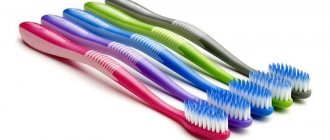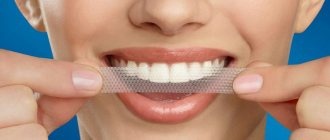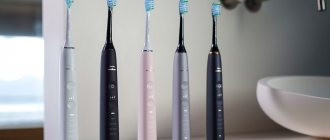Fecal coliform bacteria remain in the bathroom and are scattered throughout the room after the toilet user flushes; they can be a source of illness. You can get rid of the threat only with constant cleaning using antiseptics, but even this does not provide one hundred percent protection: particles can remain on door handles, combs and even toothbrushes.
In addition, devices for cleaning the mouth are already a breeding ground for pathogenic bacteria that remain after contact with the mucous membrane - in the future they can also cause infection. This is why it is so important to take care of their disinfection - we tell you how to approach the matter correctly.
Wash your hands before and after brushing your teeth
Bacteria and viruses are mainly transmitted through the palms - throughout the day they come into contact with many surfaces that are not always sterilely clean.
To stay safe during and after brushing your mouth, you should rinse your hands with soap and water for 20 seconds to remove any particles that might be left on the brush handle. After the procedure, you should also wash your palms to be on the safe side. In an interview with Insider, William Martin, president of the Maryland Dental Association, said that hand rinsing should, in principle, be a basic activity of every person - it will help reduce the risk of contracting viruses and infections, as well as minimize contamination of surfaces that a person touches.
Proper use is important
Following good personal hygiene will not only keep your teeth healthy, but will also minimize the risk of bacteria colonizing your toothbrush. For it to serve faithfully, it is necessary:
- Use only a separate, personal brush. The oral cavity of every person is teeming with billions of bacteria. At the same time, everyone has their own microflora, which is in harmonious coexistence with the body. When someone else's microflora gets into another person's mouth, the result can be unpredictable. To protect themselves from diseases, all family members, including husband and wife, should have personal brushes.
- Brush your teeth regularly in the morning and evening for 5-6 minutes. Timely cleaning helps suppress the proliferation of microbes in the oral cavity. Accordingly, there are fewer of them left on the brush.
- Choose the right bristle stiffness and toothpaste. The less bacteria in your mouth, the cleaner your stubble remains. The correct selection of toothpaste and brush guarantees complete cleansing of teeth from plaque, in which pathogenic microorganisms live.
- After each meal, use dental floss and mouthwash. Brushing your teeth 3-4 times a day is practically impossible physically, and is also traumatic for tooth enamel. However, to prevent food debris from rotting between the teeth, they must be removed and washed off with mouthwash.
- Change your toothbrush every 3 months. Numerous studies have confirmed that within 90 days the brush is colonized by pathogenic organisms from the oral cavity. Even high-quality disinfection does not destroy them. In addition, during this period, with regular use, the bristles wear out, and they can no longer properly clean the teeth.
- Buy a new brush after an infectious disease or professional teeth cleaning. Antibodies fight infection in the body. But pathogens survive well on a toothbrush, so it is recommended to change it after an illness. As for professional sanitation, it destroys 99.9% of harmful microorganisms in the mouth. To ensure that the cleaning result lasts as long as possible, it is better to throw away the old hygiene item with bacteria or give it a second life as a device for cleaning hard-to-reach surfaces.
We recommend: How to dry wash clothes at home?
Learn how to properly store your toothbrush
The American Dental Association says it should be rinsed thoroughly under running water to remove any food, toothpaste, or tartar. After this, you should leave the brush to air dry in a vertical position - most bacteria die in an aerobic (oxygen) environment.
It is important to store the brush not in a case or small container, but in a spacious place, for example, a cabinet next to a mirror: the fact is that pathogenic particles may remain on the boxes for the device. Also, the brush should be left as far as possible from the toilet and be sure to close the lid before flushing it. You should also avoid leaving multiple brushes nearby, as germs can spread when they come into contact.
When does a brush become dangerous?
American scientists have found that on average, about 100 million microorganisms live on a toothbrush that is stored open. Among them are staphylococcus and other bacteria that can lead to infectious diseases.
After brushing their teeth, the average user simply rinses the brush with tap water. But such cleaning is not effective. At best, water only washes away food debris and surface contaminants, but is powerless against microbes. If your toothbrush is left untreated, bacteria will accumulate on it, increasing the risk of tooth decay, canker sores, bad breath and other dental problems.
Disinfect the brush
If you want to take extra precautions, or if you dropped the device on the floor, you can use hydrogen peroxide or mouthwash.
The first solution is a good antiseptic that destroys harmful particles picked up by the brush from the ground. The second contains alcohol, menthol and eucalyptol, which also help get rid of bacteria. To do this, rinse the bristles under running water, pour a little antiseptic into a glass - enough to cover the brush head, and soak the device for 10-15 minutes. Afterwards, rinse it again and leave it to dry in the open air.
Read on topic:Why and how to cleanse makeup products
Electric brush care
In general, you need to care for an electric toothbrush in the same way as a regular one. The processing rules are not too different. The pocket with batteries and microcircuit is reliably protected from moisture, so the device can be washed without fear.
However, there are several important nuances that need to be taken into account when caring for an electric brush:
- The bristle head wears out within 3 months and must be replaced.
- Discharged batteries should never be left in the device. They may start to leak. Then not only will the brush be damaged, but the acid may get into your mouth and cause poisoning.
- After use, the electric brush should be rinsed with warm water and dried.
When trying to disinfect the device, it is important not to overdo it. Boiling may cause the product to melt. According to GOST, an indicator of 1000 CFU/cm3 of microorganisms on bristles is the norm and, in the absence of diseases of the immune system, cannot lead to infection.
Every day, billions of bacteria come into contact with your toothbrush from your mouth. Among them are streptococci, staphylococci, E. coli, porphyromonas gingivalis, herpes and hepatitis viruses A, B, C, candida albicans, coliform and many others. Improper care can lead to frequent illnesses. It is important to thoroughly wash and dry the bristles, choose a suitable place to store brushes, and observe personal hygiene rules. Every 3 months the device must be replaced.
Use ultraviolet light
According to a study published in the American Journal of Dentistry back in 2008, UV light kills bacteria and some viruses by disrupting their molecular bonds. It also found that light was slightly less effective than alcohol or peroxide, but if you have an ultraviolet lamp on hand, this is a good way to use it.
Leave the brush next to it for a few minutes, then air it out in the open air. We do not recommend using a dishwasher or microwave as an alternative - the high temperature inside the equipment can damage the brush or even melt it.
Why do you need to brush your teeth?
Oral hygiene is not only a matter of aesthetics. It is due to medical reasons. A plaque constantly forms on the enamel, consisting of: • food particles; • saliva; • waste products of microorganisms inhabiting the oral cavity.
The process of plaque deposition does not depend on whether a person ate in the interval between brushings. If it is not removed, over time it turns to stone. Contamination not only creates a cosmetic defect. Deposits contribute to the violation of the integrity of the enamel. Pathogenic bacteria penetrate into the resulting cracks and actively multiply under conditions of poor hygiene. This is how caries begins with all the known consequences. These microorganisms also attack the gums. In people who neglect to brush their teeth, gingivitis becomes chronic. If the inflammation is not treated, complications in the form of periodontitis and periodontal disease are possible. As a result, the root no longer holds in the socket and the tooth falls out.
Keep your brush safe while traveling
To ensure that it does not become a breeding ground for bacteria, get a separate case or cosmetic bag where only the cleaning device will be stored.
Upon arrival, unpack your things, leaving the brush in the bathroom and rinsing it first. Before you leave, rinse it, dry it thoroughly, disinfect the storage case and place the brush in it.
Storage rules
Germs simply love dark, damp, cool places, like the bathroom. In such conditions, they remain viable for a long time and reproduce. For example, on a poorly washed wet brush. The correct way to store it is as follows:
- Use a special vertical cup with a separate hole for each toothbrush. It is important to avoid cross-contamination from other surfaces, including brushes from other family members.
- Take care of ventilation. The washed bristles should dry completely. Do not place the brush directly into the container. By and large, it is intended only for transportation or storage on the road.
- For a shared bathroom, choose a storage location away from the toilet. When flushed, harmful particles enter the air and then settle on nearby surfaces within a radius of 1.8 m. If it is impossible to move the brush over such a distance, you should purchase a protective cap with ventilation holes.
- Keep the brush storage container clean. Wash the cup or holder at least once a week with soap and hot water. To remove stains, use baking soda and a sponge that has not been used on the sink or other surfaces.
How to care?
Stay up to date! If you use modern hygiene products, they are equipped with special color indicators that determine the degree of contamination of the product and indicate that it is time to take care of them.
If you lower the brush into water, the indicator changes color and shows whether the device can continue to be used.
You can extend the life of the product if you know some features of caring for it:
- You should not share your toothbrush with someone else. Microbes to which another person’s body is already adapted cannot overcome yours.
- After cleaning your mouth, rinse the product under running water and then allow it to air dry.
- Do not store the device in an airtight container , as it cannot dry out there, causing germs to develop.
- The product needs to 3-4 times a year .
For your information! Proper care of this hygiene item will extend its service life, improve the quality of hygiene procedures and prevent the development of inflammatory diseases of the cavity.
How often to disinfect
Do you need to clean your toothbrushes often? No. If you wash them in hot water after each use and store them properly (away from the toilet), you can clean them about once every month or so. Hot water from the sink really helps remove potentially dangerous germs.
Frequency of toothbrush cleaning
Sanitation vs. Sterilization
When shopping for toothbrush sanitizing products, it is important to understand the current lingo. The concept of "disinfect" means to remove disease or infection, but the rate of this process in each individual case can vary greatly. “Sanitation” means reducing bacteria by 99.9 percent. “Sterilization” is the process of destroying all living organisms. It is important to know that there are currently no commercially available toothbrush cleaners that can sterilize or sanitize them. Don't believe promises of complete destruction of all bacteria, because this is just a marketing ploy.
You can buy toothbrush cleaner, but no evidence suggests that these products clean them any better than plain water and drying. If you decide to purchase a sanitizer, look for a product that has been approved by the Food and Drug Administration.
Toothbrush
The bad news is that germs are everywhere and there is no escape from them. The good news is that most of them are actually incapable of harming us. So, don't try too hard to change your toothbrush routine, if at all. Most people have very little chance of ever getting sick from their own toothbrush. Read about waxed dental floss on our website.
Duration of operation
Each dentist may give different advice regarding the duration of use of one device. The best option is one month, but up to 100 days is acceptable. You can purchase special brushes that have wear indicators.
You need to buy a new item in the following cases:
- service life exceeded 3 months;
- after suffering from any diseases of the gums, teeth and oral cavity, including runny nose and common colds;
- the bristles began to “look in different directions”, some of its elements became bent and worn out - in this case, brushing your teeth will be less effective.
The note. Before the first use, simply rinse the purchased device in running water, after soaping the bristles.
How to brush your teeth with gingivitis?
Inflammation of soft tissues is not a reason to neglect hygiene. On the contrary, the more often cleansing is done, the less chance bacteria have to support the inflammatory process.
However, you need to take precautions: • choose brushes with soft bristles (preferably rounded); • choose a paste with low abrasiveness and containing medicinal herbs; • give preference to the Bass method, and abstain from the Fones method until remission; • move your hand more carefully to avoid painful sensations.
Cleaning time should not be shortened, even if the procedure causes discomfort. Sometimes dentists even recommend increasing it. Inflammation of the gums is accompanied by the formation of pockets. Where their edges lag behind, stone grows with particular intensity. This place deserves more careful study.
How to store and how not to store?
It is worth noting! Proper storage of a personal hygiene item will extend the life of a personal hygiene item, and for this you need to follow some recommendations:
- Keep products only in a dry and ventilated place. A bathroom cabinet is not suitable for this, as it has high humidity, elevated temperature and lack of natural light. These conditions are favorable for the proliferation of pathogenic microflora.
- It is best to allocate a separate cup for dental cleaning equipment Just don’t store several items in it at once.
- After suffering from a cold or acute respiratory viral infection, you need to change or thoroughly disinfect your dental appliance. For these purposes, special devices are suitable, for example, a sterilizer for such products. Thanks to it, you can sterilize the device quickly and efficiently at home.
- The container where the product is stored must always be clean.
- Once every 3 days, you need to disinfect the device using an antibacterial rinse or special solutions that can disinfect the bristles.
- Store the product only with the head up. Thus, the hairs will dry quickly, microbes will not multiply, as a result of which the device will not turn black and will not deteriorate so quickly.
- Flies and other insects should not land on the surface of the brush, as they can act as carriers of the disease.
- In reserve , you need to take care of a special case in which you can store the product while traveling.
Remember! Even a person who regularly disinfects their device needs to change their toothbrush every 3 months.
The fact is that over time, the hairs will become soft and will no longer be able to fully perform their functions.
The benefits of brushing your teeth with an electric brush
Plus No. 1: it copes with soft plaque on enamel twice as effectively as a classic brush
The results of clinical studies prove that an electric brush cleans twice as well as a regular one. When you perform the procedure manually, the pressure applied, the nature of the movements and the cleaning time may vary. Your hand gets tired, you are in a hurry, and quality suffers from all this. With an electric device, all you need to do is move the head of the device correctly from one tooth to another. The nozzle rotates to reach the most remote areas and remove soft plaque.
Independent researchers in their works repeatedly draw attention to the fact that people who first used conventional mechanical brushes, and during the experiment electric ones1, were able to improve the condition of the oral cavity, reduce the amount of hard plaque, and improve the condition of the gums. Moreover, these facts were confirmed by dentists.
Plus No. 2: effectively cleans the entire surface
The head of this brush is made to completely cover one or two teeth, depending on the shape of the head. This means that the bristles remove dirt both from the fissures of the molars and in the places where they meet the gums, as well as in the interdental spaces.
Pro #3: Makes oral care more fun
Over time, cleaning becomes a routine, tedious process that we strive to finish as quickly as possible. A modern gadget can open up this procedure from a new perspective. A spectacular appearance, useful functions (for example, a timer), and most importantly, an impressive result will make the daily procedure a pleasant ritual that you will remember with pleasure.
This is especially true for children who are usually too lazy to brush their teeth. Devices for babies often feature bright colors, ultra-soft bristles, and stickers of favorite cartoon characters, as well as other extras (such as synchronization with educational interactive applications) that distract and entertain the child. Thanks to this, brushing your teeth does not cause rejection and is associated with positive emotions. In addition, due to the sounds produced, such advanced devices, according to some independent researchers, can reduce children’s fear of the drill.
Pro #4: Controls your time
Dentists advise spending at least 2-3 minutes cleaning your mouth. If you do this for less than the allotted time, the positive properties of the paste will not have time to take effect, and some of the dirt and plaque will remain on the teeth. Despite this fact, many people do not keep track of how much time they spend cleaning. An electric brush helps control this important point. Many models are equipped with a built-in timer that will tell you when to move on to the next section. This way you will avoid excessive stress on the enamel and achieve a good result.
For more information about what features you should pay attention to when choosing a gadget, read the thematic material: how to choose a good electric toothbrush for an adult.











